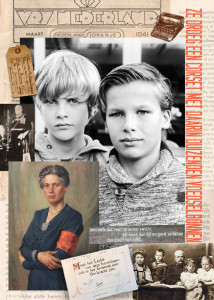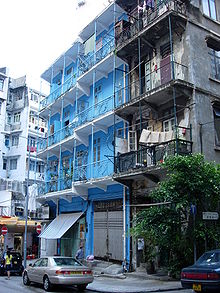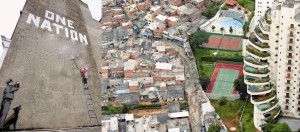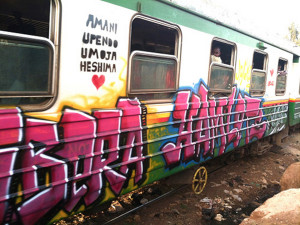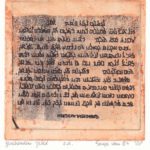Het verhaal is nooit af… ~ Een korset met duizenden voedselbonnen
“Het is best heftig wat zich allemaal in mijn familie heeft afgespeeld. Mijn opa is Paul van Tongeren. Zijn vader Hermannus van Tongeren jr werd in 1944 met een nekschot doodgeschoten door de Duitsers vanwege zijn verzetswerk. Mijn opa is als tweejarige zijn vader kwijtgeraakt en zijn moeder was zo in shock dat ze niet meer heeft gesproken. Dat vind ik een heel naar verhaal”, vertelt de 12- jarige Sies van Tongeren in het Groningse Haren. Zijn broertje Mart (8 jaar) zit bij het gesprek.
De zuster van hun overgrootvader was Jacoba van Tongeren. Zij was zesendertig jaar toen de oorlog uitbrak en rolde via haar vader, Hermannus van Tongeren sr, generaal en grootmeester in de Orde der Vrijmetselaren, meteen het verzet in. Als oud-militair bracht hij haar militaire beginselen van geheimhouding bij. “Ze is door hem als een jongen opgevoed. Ze heeft als klein kind met hem in de bushbush gewoond in Nederlands-Indië, omdat haar moeder haar niet als kind wilde. Jacoba is waarschijnlijk de enige vrouw die tijdens de Tweede Wereldoorlog een grote verzetsgroep heeft geleid, Groep 2000. Ze was door haar vader getraind om sterk te zijn. Sommige mensen vonden het raar dat een vrouw leidster was van een groep. Maar ik beschouw haar als een stoere vrouw. Ze dacht aan anderen. Dat vind ik bijzonder.”
“Ze droeg een korset met daarin duizenden voedselbonnen. Ze deed net alsof ze zwanger was. De Duitsers stonden voor haar op.”
Groep 2000 werkte met een code die Jacoba van Tongeren had bedacht met het oog op veiligheid. Alle groepsleden, maar ook de vele onderduikers die zij ondersteunde, werden niet met hun eigen naam genoemd maar met een cijfercode. Ook het adres was gecodeerd. Alleen met een sleutel kon je de codes ontcijferen. Uiteindelijk liep het toch mis. Op vrijdag 9 maart 1945 werd het hoofdkantoor van Groep 2000 aan de Stadhouderskade 56 door de Duitsers bezet. Alhoewel Jacoba strikte orders had gegeven dat als er niet op kantoor werd gewerkt, de codesleutel meegenomen moest worden, bevond die zich toch nog op de Stadhouderskade toen de Duitsers er die vrijdagavond binnenvielen. Read more
Newsweek ~ Quora Question: What Is It Like To Live in Hong Kong’s Cubicle Apartments?
Quora Questions are part of a partnership between Newsweek and Quora, through which we’ll be posting relevant and interesting answers from Quora contributors throughout the week. Read more about the partnership here.
Answer from David Yu.
It’s a different mind set. I lived in Hong Kong for 12 years, and in the U.S. for 17 years (different cities/suburban). Most of the cities feel like a giant Monopoly game, but no other city comes close to Hong Kong. Everything is tighter in Hong Kong; it’s important to have a good concept of caching your stuff (not in a computer programming way, but similar).
Read more: http://www.newsweek.com/hong-kongs-cubicle-apartments
Christina Culwick ~ Why Gated Communities Threaten Democratic Cities
Recently I tried to drive through a gated section of Westcliff , an affluent suburb in Johannesburg, to avoid traffic, only to be stopped by the guard at the boom and informed that I was not permitted to go through. I insisted that I had every right to enter, since it was a public road so I couldn’t legally be prevented from entering. The guard was not convinced. I went on to claim my right to freedom of movement and he maintained his position to restrict it. Our back and forth continued – neither party budging, and both getting more indignant. Eventually I stormed out of my car, lifted the boom myself and was instructed by another guard to “Just go”.
Reflecting on this incident, I feel I should declare that I am a white, middle class South African who benefited from apartheid, and live adjacent to Westcliff. I acknowledge that the private security guard with whom I argued has likely experienced restriction of movement to a degree I cannot comprehend, and his experience of exclusion in Westcliff is likely far greater than mine. His job is to implement a system. My issue lies not with him but with that system.
Read more: http://futurecapetown.com/gated-communities
Samantha Spooner ~ Hubs Of Innovation, Art And Culture; These Are The Hidden Treasures Of Africa’s Slums
As part of the BBC’s “A Richer World” season, renowned Swedish statistician Hans Rosling recently discussed how West Africa managed to contain the Ebola virus.
It is a fascinating presentation, and part of it illustrates how the trajectory of things tend to change dramatically when they arrive in an African slum.
Sometimes it is for the worse, as in the case of Ebola. Other times, it is for the better, as with culture.
So it is with Semba, the type of infectious music that is always sure to snag the usual body wigglers in the room. Its rhythm combines a delicious mix of lively African beats, smooth samba tones and fast-paced Caribbean Zouk flavour to produce a sound that will keep you hip-locked for hours.
It’s easy to understand how this music got its name; semba comes from the singular Masemba, meaning “a touch of the bellies”, a move that characterises the appropriate semba dance stance.
Semba’s roots
Semba originated from the slums or musseques of Luanda, Angola, in the early 1960s. Urban Angolans began to take advantage of reforms in colonial policy and began to improve their daily lives, which included the creation of new cultural spaces. The production of semba, a local form of urban popular music, was at the forefront of this process.
Today the music is as alive and popular as it ever was, with new artists emerging every year. In fact, any conversation about contemporary Angolan music must always begin with semba. It has also achieved international popularity, particularly in Lusophone countries and across West Africa.
It goes to show, you cannot judge a book by its cover.
Read more:http://m.mgafrica.com/the-hidden-treasures
Nikolaos Karagiannis & C.J. Polychroniou ~ The Scourge Of Dependency And Globalization In The Caribbean
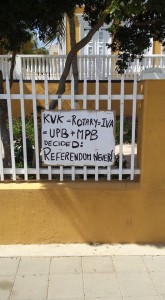 truth-out.org. April 2015. Historically, the Caribbean countries developed under the tutelage of different European empires, and more recently under North American dominance. As a result, the Caribbean came to be a classic area of plantation society as there is a certain unity to the region’s development and in its patterns of historical evolution. Furthermore, the plantation economy models emphasized the historical continuity of Caribbean dependence from the slave plantation to modification following emancipation, to further modification in the post-colonial era. Political independence established national sovereignty (i.e., “flag independence”) in older and newer nations of the Commonwealth Caribbean, when both groups were integrated into the international system. Consequently, the political process of national independence converted states, societies and nations that had evolved as integral parts of the global system. The effect was to legitimize their autonomy based on concepts of self-determination.
truth-out.org. April 2015. Historically, the Caribbean countries developed under the tutelage of different European empires, and more recently under North American dominance. As a result, the Caribbean came to be a classic area of plantation society as there is a certain unity to the region’s development and in its patterns of historical evolution. Furthermore, the plantation economy models emphasized the historical continuity of Caribbean dependence from the slave plantation to modification following emancipation, to further modification in the post-colonial era. Political independence established national sovereignty (i.e., “flag independence”) in older and newer nations of the Commonwealth Caribbean, when both groups were integrated into the international system. Consequently, the political process of national independence converted states, societies and nations that had evolved as integral parts of the global system. The effect was to legitimize their autonomy based on concepts of self-determination.
Read more: http://www.truth-out.org/the-scourge-of-dependency
Uttam Kumar Saha ~ Action Needed In Bangladesh Urban Slums
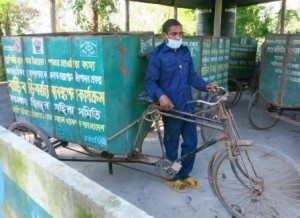 Bangladesh has been facing the fastest urbanisation in South Asia. Currently, around 30% of 160 million people live in urban centers and contribute 60% of the GDP of our country. The Urban Authorities (11 city corporations and 324 municipalities) are responsible for providing a wide range of basic infrastructural (e.g. water supply, sanitation, waste management) and social services for a livable and healthy environment for all urban dwellers. Slum dwellers and low income communities (around 20-25% of total urban population), essential and important stakeholders who are contributing USD 5.5 billion annually to GDP), remain deprived and excluded from formal services. Slums are characterised by high population density, limited sanitation and hygiene facilities, poor housing, a very low socio-economic status for a majority of residents, a lack of security of tenure and poor governance. Where those services do exist, quality is low and costly to afford. Despite their significant contribution to the urban economy, unplanned growth leads to polluting environment and adverse impact on public health and poverty reduction.
Bangladesh has been facing the fastest urbanisation in South Asia. Currently, around 30% of 160 million people live in urban centers and contribute 60% of the GDP of our country. The Urban Authorities (11 city corporations and 324 municipalities) are responsible for providing a wide range of basic infrastructural (e.g. water supply, sanitation, waste management) and social services for a livable and healthy environment for all urban dwellers. Slum dwellers and low income communities (around 20-25% of total urban population), essential and important stakeholders who are contributing USD 5.5 billion annually to GDP), remain deprived and excluded from formal services. Slums are characterised by high population density, limited sanitation and hygiene facilities, poor housing, a very low socio-economic status for a majority of residents, a lack of security of tenure and poor governance. Where those services do exist, quality is low and costly to afford. Despite their significant contribution to the urban economy, unplanned growth leads to polluting environment and adverse impact on public health and poverty reduction.
Read more: http://practicalaction.org/bangladesh-urban-slums/
- Page 2 of 3
- previous page
- 1
- 2
- 3
- next page
